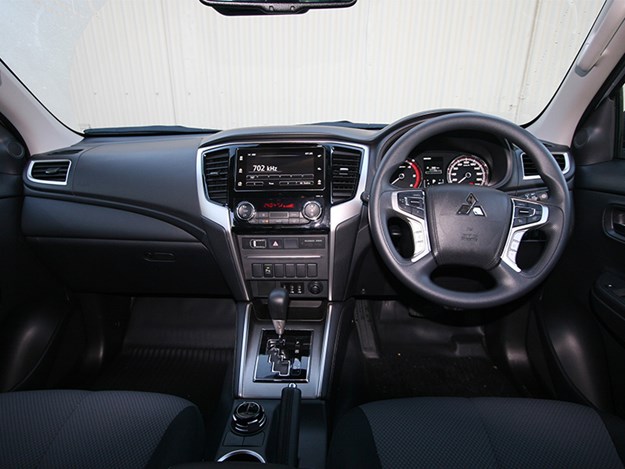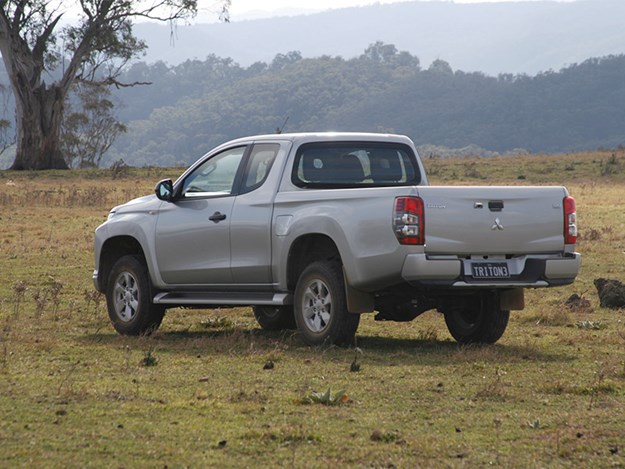Don’t need the five seats of a dual cab but need more room than a single cab? Then try this Mitsubishi Triton Club Cab for size
 |
|
The MR model Triton has a far more aggressive front-end styling compared to the now superseded Triton MQ
|
You can’t help but notice the new – MR model – Triton given its far more aggressive front-end styling compared to the now superseded Triton MQ. What’s underneath the MR’s new face is, however, more familiar with the engine and chassis largely carried from the previous model. And where the MQ was more a generation change from the MN of 2009, bringing a new engine and significant chassis changes, the 2019 MR is largely a mid-generation facelift of the MQ.
However, there are mechanical changes with a new six-speed automatic gearbox replacing the previous five-speed auto. A new six-speed manual arrived with the MQ, so that’s carried over to the MR. Changes to the rear suspension also means that GLX and GLX+ models get an extra leaf in the rear springs. Larger diameter suspension dampers are also fitted at the rear, all these changes no doubt designed to address the criticism of the previous model’s rear suspension performance when carrying heavier loads.
Climb Aboard
The MR Triton offers a wide range of dual-cab models and a lesser number of single-cab models in both four-wheel-drive and two-wheel-drive. The extended or Club-Cab model – as tested here – only comes in 4wd but is available as a cab-chassis (add your own tray) in entry-level GLX specification in both manual and automatic. Or you can opt for a factory tub as per our test vehicle, which is GLX+ specification and automatic only. It’s priced from $40,490 (plus on-road) costs.
Being a GLX+, there are sidesteps and alloy wheels to distinguish it from the more utilitarian GXL but you still don’t get ‘Smart Key’ entry and start, carpets or embedded sat-nav.
But that’s not to say that it’s sparsely equipped given it has high-end safety features such as autonomous braking, lane departure warning and a reversing camera, as well smartphone connectivity through Android Auto and Apple CarPlay.
It’s a fair step up to the cabin of the Club Cab but the assist handle on the A-pillar, as well as the sidesteps, are there to help if need be. Once on board you’ll notice the cabin isn’t as wide as the bigger utes such as Ranger, BT-50 and Amarok but shouldn’t have any trouble getting comfortable thanks to both tilt and reach steering wheel adjustment. Many utes (Ranger and BT-50 included) only have steering-wheel tilt adjustment.
Access to the rear of the Club-Cab is via two rear-hinged ‘half doors’ that can be only opened once the corresponding front door has been opened. In the rear of the Club Cab are two small fold-down seats designed for short-distance, occasional use. If the driver and front-seat are tall and have the front seats pushed back, the rear legroom isn’t very good but if those up front aren’t too tall, or can squeeze up a bit, the rear legroom isn’t too bad. Both the rear seats have lap-sash seat belts.
When not in use the seat bases can fold up to improve the functionality of the rear space for general luggage and gear carrying. There’s also a small stowage area under the rear seats.
 |
|
There are mechanical changes with a new six-speed automatic gearbox
|
On the Road
The Triton’s 2.4-litre diesel was new from the ground up in 2015 and is common to all diesel Tritons, dual-cabs included. It’s a responsive and energetic engine and while it likes to rev more than bigger engines in competitor utes it never feels strained or particularly fussed. It’s also relatively quiet, smooth and refined, especially once underway, even if there’s no mistaking the telltale diesel sound at idle.
For its part the new six-speed automatic gearbox offers improved shift quality and shift timing, as well as a performance benefit over the previous five-speed thanks to a closer ratio spread.
On the road the Triton feels smaller than all of its immediate competitors with steering that is direct and positive. It handles nicely too for a ute, as long as the road is reasonably smooth, but it’s less settled and less comfortable on rough roads than Triton’s dual-cab variant when unladen.
In the Paddock
The Club-Cab’s conventional part-time 4wd is operated via a rotary dial. High-range 4wd can be selected on the move and engages and disengaged easily. To engage low-range 4wd you have to stop however and, like many utes with this style of electronic shifter (rather than a lever), four-low can be slow to engage and disengage.
For paddock work the Triton’s ground clearance seems far better than the 205mm claim while the good vision from the driver’s seat helps not running over something you don’t see. The Triton also has the tightest turning circle of its competitors, which is can be handy at times.
The Club-Cab comes with paddock-friendly all-terrain tyres (on 16-inch steel wheels) rather than the ‘highway’ tyres fitted to many work utes but still doesn’t do as well on really rough ground as most competitor 4wd utes, which have more wheel travel. Unlike the higher-spec Triton dual-cabs there’s also no driver-activated rear differential lock although it does have electronic traction control, which performs a similar function as a locking differential, which can help get the Club Cab out of trouble.
 |
|
The Titon’s ground clearance is good and it has the tightest turning circle of its competitors
|
Load Carrying and Towing
With the shorter Club-Cab cabin (as opposed to a dual-cab), the tray gains about 300mm in length to run to handy 1.8 metres long. As per the dual-cab models, the tray width remains at 1.5m.
Despite its relatively modest Gross Vehicle Mass of 2,900kg the Club Cab has a maximum payload rating approaching a tonne (974kg to be exact), thanks largely to the fact that it’s relatively light as far as utes go.
Not being able to fit a full-size pallet between the wheelarches unfortunately meant we couldn’t put 800kg (our standard test load) on a pallet and load it via a forklift, so we settled for a 500kg of sand bags loaded by hand. With that weight on board the rear of the Triton dropped 50mm at the axle line and the nose came up just 5mm, so still a reasonably neutral stance.
Once underway with that load in the tub (plus another 150kg in driver and passenger) the steering remained positive and the handling tidy and predictable. You could still feel the extra weight but overall the Club Cab gave the impression that it would manage more weight before the steering or handling deteriorated, an improvement on the previous model due no doubt to the suspension upgrade. All good engine-wise too with adequate power to haul that load even up hills without fuss.
With no towbar fitted we wouldn’t test the Club Cab towing ability but is rated to tow 3,000kg, which is 500kg less than the best in class and, if experience with the previous model is anything to go by the Club Cab would be happy towing anything up to 2,500kg but wouldn’t be a first-choice ute to tow more.
The Bottom Line
Much of what you can say about the Club Cab applies to the equally popular Triton dual-cab models. That starts with sharp pricing and good value for money and extends to being a handy, well performing and comfortable everyday ute that’s a bit smaller and easier to park than most competitor utes. But the Triton is also more a medium-duty rather than heavy-duty ute when it comes to carrying or towing loads.
Compared to the Triton dual-cab models, the Club Cab’s major benefit is a significantly longer tray while its major shortfall is that it can only carry four people, and then only over shorter distances and for occasional use. Otherwise it’s like two-seater single-cab with decent amount of stowage behind the front seats. It’s also worth noting that the Club Cab, unlike the Triton dual cabs, isn’t offered with Mitsubishi’s ‘Super Select’ 4wd system, which brings the significant safety and functionality benefits of full-time 4wd.
SPECS:
Mitsubishi Triton Club Cab GXL+ (4wd)
Engine 2.4-litre four cylinder turbo diesel
Max power 133kW @ 3,500rpm
Max torque 430Nm @ 2,500rpm
Gearbox Six-speed automatic
4WD System Part-time dual-range
Front suspension Independent/coil springs
Rear suspension Live axle/leaf springs
Wheel type Alloy
Tyre specification 245/70R16 111S
Unladen weight 1,926kg
GVM 2,900kg
Payload 974kg
Towing capacity 3,000kg
GCM 5,785kg
Overall length 5,295mm
Width 1,815mm
Height 1,780mm
Wheelbase 3,000mm
Ground clearance 205mm
Fuel tank capacity 75 litres
ADR fuel claim 8.6 litres/100km
Test fuel use 9.5 litres/100km
Range 823km*
PRICING:
Mitsubishi Triton prices*
2wd GXL Single-cab/chassis (petrol) $22,490
2wd GLX Single-cab/chassis $25,990
2wd GLX Dual-cab ute (auto) $36,290
4wd GXL Single-cab/chassis $32,990
4wd GXL Club-cab/chassis $35,490
4wd GXL Dual-cab/chassis $36,240
4wd GXL+ Club-cab ute (auto) $40,490
4wd GXL Dual-cab ute $37,490



.jpg)